
As you may have noticed, the title
"Ayatsuri Sakon" is preceded by the words "Karakuri Zoushi." The word
"karakuri" has many different interpretations. Simply, it can mean
"doll" or "puppet." However, in relation to dolls or puppets, it can
be translated as: trick, clockwork, mechanical, manipulated, etc. The word can also be
used in reference to puzzle and/or mechanical boxes and toys.
In manga and anime, "karakuri" has
evolved into an umbrella term of sorts, used to describe many different puppetry
techniques. For example, take the word "marionette." We have come to associate
with stringed puppets. In France and other European countries, "marionette"
refers to all kinds of puppets. This is because of the word's origins. Early puppet
performances in France were done with stringed puppets and were biblical plays about the
Virgin Mary. "Marionette" means "little Mary" in French. As puppetry
spread and became more sophisticated, the term became exclusive to puppets of the
stringed variety. But it still has the all-encompassing meaning as well.
"Karakuri" is much the same way. It can be used in direct reference to
mechanical or trick puppetry, or it can be used for other styles.
| Traditionally, Karakuri were special
mechanical dolls used as displays in parades or in the private homes of the wealthy as
entertainment for guests. One of the most common types of Karakuri is the tea-serving
doll. Constructed with wooden and whale-bone gears, this puppet moves forward when a cup
of tea is placed on a tray in its hands. Removing the cup causes the puppet to turn around
and return to its former position. This style of Karakuri doll appears in Ayatsuri Sakon's
second storyarc (in manga volumes one and two). The first doll (Figure 1) stays
in a fixed display, but is without robes, so the inner design is revealed. (This stands as
one of the reasons I adore this series. The artist put a great deal of research and detail
into every aspect of the story, especially puppetry.) The second doll to appear (Figure
2) is fully clothed and is carrying the bloody head of another Karakuri on her tray.
To view some incredible images of both parade and room Karakuri, please visit The Karakuri. For a more
intricate look at a tea-serving doll as well as a walkthrough of its internal workings,
visit Karakuri
Doll. Here is another incredible Karakuri
Gallery site. In addition to being a
form of entertaining guests, Karakuri was incorporated into Bunraku productions in the
1600's. Competing theatres started trying to outdo one another in every aspect of
performance to draw in the crowds. New plays, more articulate puppets, changing
performance styles, and special effects were some of the methods they employed. Karakuri
proved very helpful in executing superhuman or miraculous feats. These mechanical
dolls were fitted with long strings that could be worked from offstage. The strings
most likely triggered some preset action. In a sense, this combined the arts of
Karakuri and Marionettes ( which had only minor successes in Japan before Bunraku). This
style of Karakuri puppet has become the focus of several manga series. Karakuri lives on
today mostly in temples, shrines, and festival parades. |
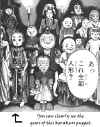
Figure 1
click for full image (71k)
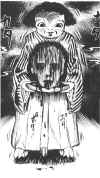
Figure 2
click for full image (48k) |
| Interesting Trivia: Why
does Sakon wear that weird collar? Take a close look and you'll see that it is made
up of a couple oversized mechanical gears. This is, we believe, kind of an ironic
joke amongst the creators. The Kanji of the title is usually used for "Ningyo"
(doll or puppet) but can also be read as "Karakuri." I am not sure of what
the creators' exact intentions were. They may have just wanted to give Sakon's
outfit a hint of puppet. I wonder if they are trying to use it as a way of
symbolizing Sakon's passiveness in relation to Ukon's aggressive personality. The
theme of "the puppeteer as a puppet" is very common (Being John Malcovich, for
instance), and I wouldn't be surprised if this is being represented with the characters of
this manga. Granted, this is speculation on my part. Until we get a solid
interview with the creators, we won't know for sure! |
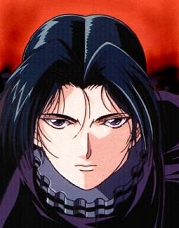 |
"Karakuri" has also shown up in
several other manga titles. Here's a closer look at a couple more of them:
| Karakuri no Kimi (Puppet
Princess) Visit
our shrine and gallery for this series!
http://www.clockworkvoices.com/karakurinokimi |

click for full image (46k) |
|
|
Karakuri Circus (Puppet
Circus)
Created by Fujita Kazuhiro (of "Ushio and Tora" fame), Karakuri Circus follows
the strange circumstances of a wealthy boy named Masaru. Many people are interested in
using him (through ransom) to get rich. However, Masaru has Shirogane, a master puppeteer
who utilizes her skills and her lifesize puppet to protect him. This manga is one of many
that uses Karakuri in a broader sense. The large, and unique puppets (those of the good
guys and the bad ones) are mostly controlled externally with strings and wires by
their puppeteers. Other puppets (henchmen and the like) are more of the basic 'mechanical
doll' Karakuri design, and are without puppeteers.
For more on this series, please visit
Animanga
Community's Karakuri Circus page. |
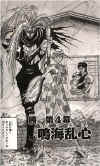
click for full image (110k)

click for full image (55k) |
Genzou Hitogata Kiwa
This manga is from the renowned creator of 3x3 Eyes, Yuuzou Takada. The title character,
Genzou, travels the country, using his mastery of puppet building and manipulation to help
those in need. His puppets are very realistic and often get mistaken for living beings.
The art is very precise in this one, giving much detail into his construction techniques.
The puppets are for the most part life-size marionette-style Karakuri. The control bars in
this manga resemble curved sword hilts (similar to the letter 'D'). He also has a small
puppet frog; it seems to vary between having strings and being independent. This series
blends well the passion of the puppeteer with action sequences,
humour, emotion, and a supernatural element. More on this series can be found at: Puppet's Heart - a Genzo Hitogata Kiwa fan site. |
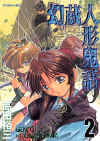
click for full image (83k)
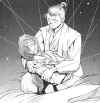
click for full image (43k) |
Å@ |